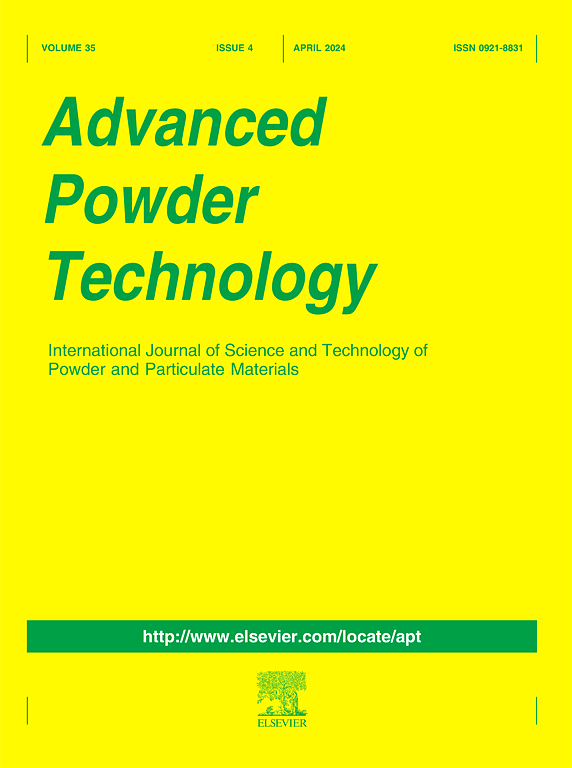具有硒空位的新型Zn/MoSe2纳米花用于环丙沙星的有效电荷分离、光电化学研究和高效可见光降解
IF 4.2
2区 工程技术
Q2 ENGINEERING, CHEMICAL
引用次数: 0
摘要
本研究考察了新型硒空位(2.5%,5%,7.5% &;10%)在水热法合成的Zn/MoSe2纳米花结构内,作为可见光下降解环丙沙星(CIP)的光催化剂。在合适的光催化反应器中分解了CIP,并测定了反应速率常数。暴露45 min后,优化的硒空位(5% Zn/MoSe2)对CIP基废水的光催化降解率最高,达到98.68%。显著的光催化活性可以归因于硒空位的产生,这阻碍了空穴和电子的重组。通过使用具有不同电负性的金属的合并,可以更容易地产生空缺。优化后的光催化剂表现出良好的稳定性,并通过循环试验和反应后表征进行了验证。该研究利用RSM模型,特别是采用Box-Behnken设计,以确定最有利的可见光降解操作参数。参数包括溶液pH、催化剂剂量和初始CIP浓度。5% Zn/MoSe2的降解效果显著,对自来水的降解率为90.76%,对湖水的降解率为86.15%。通过清除实验、TMPD和EPR实验对主要负责降解CIP的超氧自由基进行了检测。使用LC-MS发现过渡产物,然后利用它们的存在来建议降解途径。本文章由计算机程序翻译,如有差异,请以英文原文为准。

Novel Zn/MoSe2 nanoflower with selenium vacancies for the effective charge separation, photo-electrochemical study and efficient visible-light degradation of Ciprofloxacin
This research investigated the effectiveness of the novel selenium vacancy (2.5%, 5%, 7.5% & 10%) within the nano-flower structure of Zn/MoSe2, synthesized through the hydrothermal method, as a photocatalyst for degrading Ciprofloxacin (CIP) under visible light exposure. CIP has been broken down in an appropriate photocatalytic reactor, and the reaction rate constant has been assessed. After 45 min exposure, optimized selenium vacancy i.e., 5% Zn/MoSe2 shows highest photocatalytic degradation of 98.68% in CIP based waste-water. The remarkable photocatalytic activity can be ascribed to the creation of a selenium vacancy that impedes the recombination of holes and electrons. The vacancies can be created with greater ease by using amalgamation of metals possessing distinct electronegativities. The optimised photocatalyst showing a very good stability which has been checked through recycle test and post-reaction characterisation. The study utilized RSM modeling, notably employing the Box-Behnken design, to ascertain the most favourable operational parameters for the visible-light degradation. The parameters encompass solution pH, catalyst dose, and initial CIP concentration. The 5% Zn/MoSe2 demonstrated significant degradation efficiency, achieving degradation percentage of 90.76% in tap water and 86.15% in lake water. Superoxide radicals which are mainly responsible for degrading CIP have been tested using scavenging experiments, TMPD and EPR tests. Transition products were found using LC-MS, and their existence was then utilised to suggest a degradation pathway.
求助全文
通过发布文献求助,成功后即可免费获取论文全文。
去求助
来源期刊

Advanced Powder Technology
工程技术-工程:化工
CiteScore
9.50
自引率
7.70%
发文量
424
审稿时长
55 days
期刊介绍:
The aim of Advanced Powder Technology is to meet the demand for an international journal that integrates all aspects of science and technology research on powder and particulate materials. The journal fulfills this purpose by publishing original research papers, rapid communications, reviews, and translated articles by prominent researchers worldwide.
The editorial work of Advanced Powder Technology, which was founded as the International Journal of the Society of Powder Technology, Japan, is now shared by distinguished board members, who operate in a unique framework designed to respond to the increasing global demand for articles on not only powder and particles, but also on various materials produced from them.
Advanced Powder Technology covers various areas, but a discussion of powder and particles is required in articles. Topics include: Production of powder and particulate materials in gases and liquids(nanoparticles, fine ceramics, pharmaceuticals, novel functional materials, etc.); Aerosol and colloidal processing; Powder and particle characterization; Dynamics and phenomena; Calculation and simulation (CFD, DEM, Monte Carlo method, population balance, etc.); Measurement and control of powder processes; Particle modification; Comminution; Powder handling and operations (storage, transport, granulation, separation, fluidization, etc.)
 求助内容:
求助内容: 应助结果提醒方式:
应助结果提醒方式:


